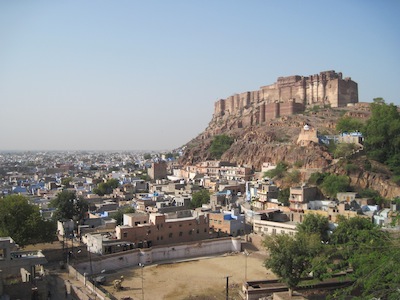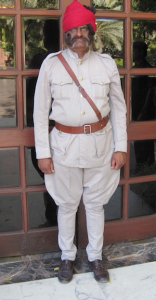Transcendental Meditation is such a great thing for travel. You can do it anywhere. In airport departure lounges, on planes, all over the place. And you feel so fresh and clear afterward.
For instance, this morning we meditated at the poolside of our Ajit Bhavan Palace hotel in Jodhpur, one of the 20 places I’m glad I visited before I die.
I’m ranking this place alongside my favorite spots in the world: the Canadian Rockies, Grundlesee in the the Austrian Lake district, Pokhara in the Nepalese Himalayas, Sun City, Bantry Bay, and the Kruger Park, oh, and Heavenly Mountain in Boone, North Carolina.
We are in Jodhpur, in Rajasthan, province of the Rajas, in the top north west corner of India. Its the second largest city in Rajasthan and has many names including “Gateway to the Thar”, “The Blue City” and amazingly enough, “Sun City”. It gets very very hot here from April.
With a population of around 1 million, Jodhpur is dominated by a huge menacing fort, Meherangarh, crouched on a pink ridge just to the west of the city centre. The fort was founded in 1459 and now houses a fabulous museum with a world-class audio-guided tourist facility. We saw an amazing royal collection of palanquins, howdahs, musical instruments, costumes and arms which gave us a feeling for the immense depth of this culture. Hats off to the trustees who had the vision to use this place to sustain Indian culture.
Jodhpur is an extraordinary city spread along the edge of the Great Thar desert, and yes, you guessed right, it gave its name to the riding trousers familiar to horse lovers.
It is a tangle of winding streets, and is built mostly of pink sandstone in a distinctive Cubist architecture. It smells of incense, rosewater and sewers, and sells everything from iPods to saffron. The people wear brightly colored turbans and deep pink saris.
Its also famous for its antiques. It is not walking country, as the pavements only seem to be maintained for few metres along storefronts. The term blue city comes from the blue paint used for buildings, particularly in the Brahmapuri village area to the south of the fort. Blue is the brahmins colour, gives a subjective coolness and is held to repel insects.
One of Jodhpur’s most colourful forefathers, Maharaja Umaid Singh built an incredible 350 room castle, Umaid Bhavan Palace, in the 1930s. The palace overlooks our place, Ajit Bhavan, also built by him. He had RAF wings, founded Jodhpur airport in 1924 and had international air traffic in here before Delhi. He was in our grandpas’ cohort, born in 1903. The airport now houses squadrons of Indian Air Force Mig 29s and Sukhois which could be seen barreling out over the desert after their deafening roaring takeoffs. I even saw one landing with its braking chute from by vantage outside Umaid Palace gate.
Vicki raided a shop called Divas today for cotton tops. Young Manchester-educated proprietor Basant is typical of the new blood of India and has opened 4 boutiques already with an eCommerce website and will send you great handprints by DHL. His dad is into vedic science, and runs a sort of ashram.
So what sort of exotic meditation destinations have you encountered?
Where was your best-ever meditation? Mine was on the 7th floor of a building in Sauer Street in Johannesburg in the old days, sitting with a bunch of steel merchants doing a meditation course!


